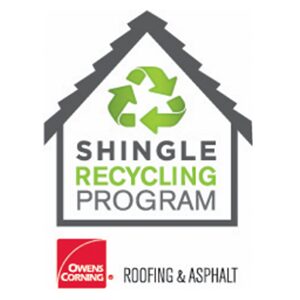Roof Inspections
Get a FREE inspection!
Fill out your info below and we will contact you.
Roof Inspections
Get a FREE inspection!
Fill out your info below and we will contact you.
Our Roof Inspection Process
Conducting a thorough roof inspection involves multiple aspects that require a high level of skill and specialized training. Edge Roofing stands out from its competitors by providing comprehensive and continuous training to its team, along with decades of experience in the field.
As a result, you can have full confidence in their ability to deliver the highest quality roof inspection compared to any other roofing company in Georgia. This page provides an overview of The Edge Roofing Residential Roof Inspection Process.
Our Roof Inspection Process
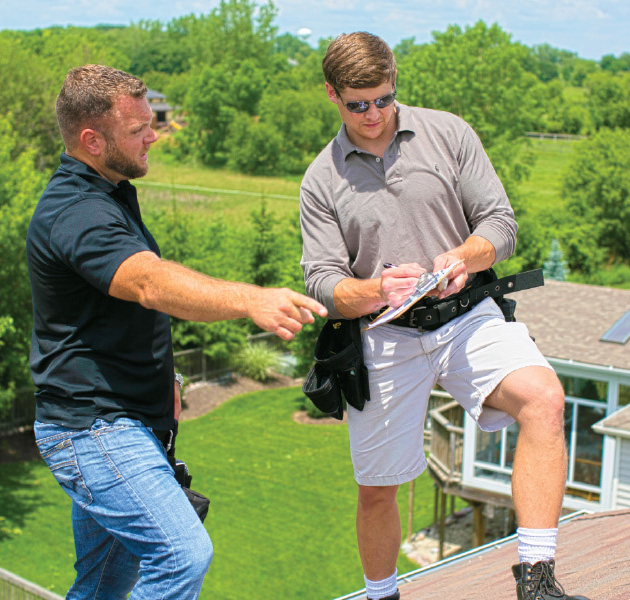
Conducting a thorough roof inspection involves multiple aspects that require a high level of skill and specialized training. Edge Roofing stands out from its competitors by providing comprehensive and continuous training to its team, along with decades of experience in the field.
As a result, you can have full confidence in their ability to deliver the highest quality roof inspection compared to any other roofing company in Georgia. This page provides an overview of The Edge Roofing Residential Roof Inspection Process.
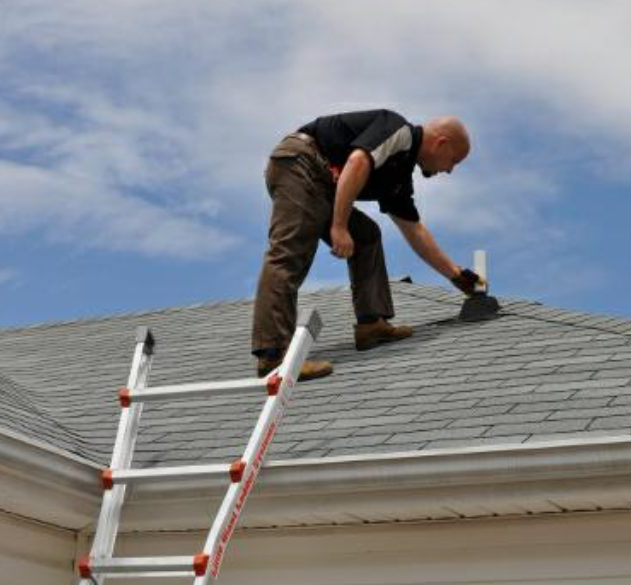
To ensure that we deliver the utmost quality in our roof inspections, we follow a series of steps. While these steps may seem simple, they require extensive and ongoing training to ensure that we provide you with exceptional service.
To ensure that we deliver the utmost quality in our roof inspections, we follow a series of steps. While these steps may seem simple, they require extensive and ongoing training to ensure that we provide you with exceptional service.
Overview of the entire process from Roof inspection to Roof installation:
Our team is available to schedule an in-person meeting with you at your home to discuss the condition of your roof. During our visit, we will carefully assess the roof’s current state and provide valuable insights and recommendations for any necessary repairs or maintenance.
Our team is skilled in conducting comprehensive roof inspections to ensure the safety and integrity of your property. During the inspection process, we carefully document any damages or potential issues that may arise. Once the inspection is complete, we will discuss our findings with you, providing detailed information and recommendations for addressing any concerns that were identified.
If your roof sustains significant damage that qualifies for insurance coverage, we will assist you in the process of filing a claim. However, if the damage is minor and does not meet the criteria for an insurance claim, we can provide you with an estimate to repair the damage instead.
What you should know before letting anyone on your roof!
Once you have filed a claim, we will arrange a meeting with the insurance adjuster at your residence. This typically takes place within 1-2 days after filing the claim. During this meeting, you will have the opportunity to show the adjuster what you have discovered.
After your insurance company confirms the need for a roof replacement, they will issue a check to cover the cost. Once that is settled, we will work with you to schedule a convenient day for the installation of your new roof. Upon completion of the installation, we will collect payment from you as agreed upon.
Get a FREE Inspection!
Complete the form below and we will contact you.
Our 6 Step
Inspection Process
Step 1
Determining the shingle type, manufacturer, and current age
Asphalt shingles are commonly used for residential roofs. During a roof inspection, it is important to identify the type of shingles from the ground, which can be done by visually inspecting your roof. This step is crucial because if you have discontinued shingles, it indicates that your roof may not be repairable. There are three main types of asphalt shingles: 3-Tab, Atlas Chalet, and Architectural.
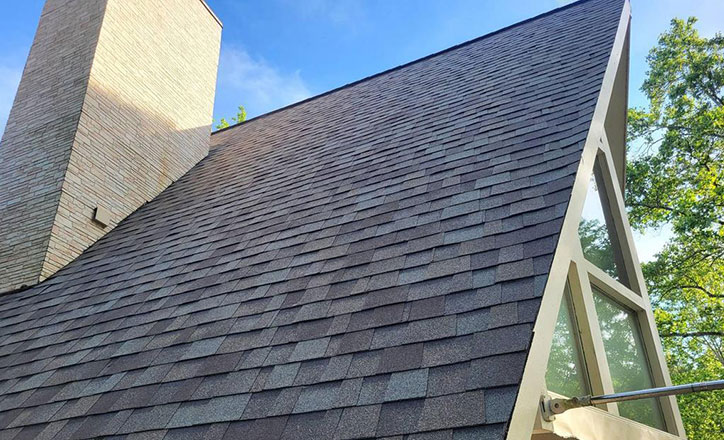
3-Tab
The 3-tab shingle is a widely chosen roofing option due to its affordability and repairability. However, it’s important to note that if the shingle has aged and fails a brittle test, it may not be repairable. In such cases, your home insurance policy typically covers the cost of roof replacement.
Atlas Chalet
The Atlas Chalet shingles have been discontinued since 2010, which means they cannot be repaired. Despite their appearance as architectural shingles, they are just 3-tab shingles. If you experience any damage to your roof, your home insurance will probably cover the cost of replacing it.
Architectural Shingle
One highly recommended architectural shingle with advanced SureNail® Technology is Owens Corning. Many consider it to be the best shingle available in the market due to its exceptional quality and durability. Edge Roofing, for instance, highly recommends this product over any other option. However, customer preferences are always taken into consideration. When choosing a roofing shingle, it’s important to pay attention to the manufacturer as well. Different brands may have varying ratings and repairability capabilities. Therefore, understanding the reputation and reliability of the manufacturer can help you make an informed decision about which shingle is best suited for your needs.
Lastly, let’s consider the age of your roof. If the roof has never been replaced, it is likely as old as the home itself. However, if the roof has been replaced but you are unsure about its age, we can make an educated estimation by taking into account other factors. By combining these three factors – age, durability, and repair possibilities – we can determine how long your roof typically lasts, identify potential vulnerabilities to damage, and establish appropriate repair approaches if needed. Moving forward, let’s now focus on assessing any existing damage.
Step 2
Determining the type and amount of damage
After assessing the interior of your house, it is advisable to move on to inspecting the exterior, particularly your roof. This step is crucial in determining if there are any damages and their extent. Types of damages commonly encountered include those caused by hail or wind. Each type possesses distinct characteristics and poses varying risks to the overall integrity of your home. Moreover, it’s worth noting that your home insurance provider may have specific requirements regarding the type and severity of damage for them to cover the cost of a new roof. To gain a better understanding of what you might be dealing with, there are four most common types of shingle damage that you should be aware of. It’s important to address these damages promptly as they could potentially lead to serious issues for your home if left unattended.
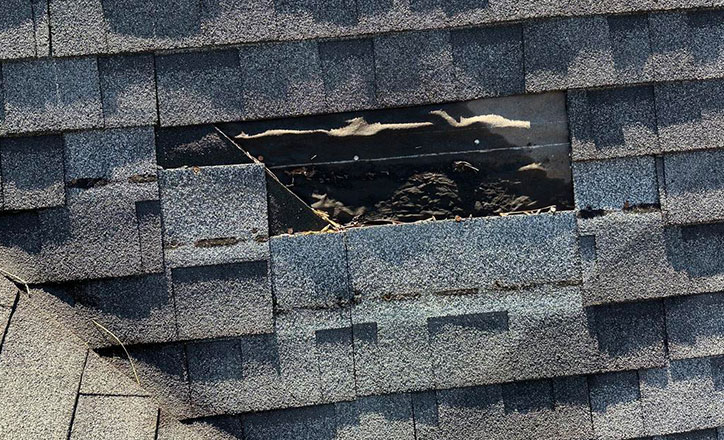
Wind Damage
Hail damage can cause significant issues to your roof. When strong winds accompany the hail, the shingles can become lifted, creased, or even detached completely. Once a shingle is lifted, its seal is broken and cannot reseal itself. In time, wind can get underneath the shingle, causing it to flap back and forth until it tears off entirely. This leaves your roof vulnerable to rainwater seeping into your home. It’s crucial to address hail damage promptly to avoid further problems with your roof’s integrity and prevent water damage inside your house.
Hail Damage
Hail damage can greatly impact the integrity of your roof. When hail hits, it can penetrate through the matting on the back of shingles, compromising their effectiveness. This means that they are no longer able to adequately protect your home from rainwater. It is important to address hail damage promptly to prevent further issues and maintain a secure roofing system.
Tree Damage
Ah, tree damage, the not-so-friendly reminder that nature can be a bit rough sometimes. Trees can cause all sorts of havoc when they decide to take a tumble or throw a branch party on your roof. Not only can they leave unsightly dents and scratches, but they can do some serious damage to your roof structure, house support, and even people’s lives.
When trees are damaged or weakened, they become unstable and more prone to falling during storms or strong winds. This can lead to damage to your home, vehicles, or other structures on your property. It is essential to conduct regular inspections of your trees, look out for signs of damage like cracked branches or leaning trunks, and take necessary measures to mitigate potential hazards.
Now, we’re not saying trees are out to get you (they’re just doing their tree thing), but it’s important to address any tree-related damage ASAP. Those fallen branches and wayward limbs can weaken the integrity of your roof, leaving it vulnerable to leaks and other unwanted surprises.
Age
When a roof ages, it goes through various signs of deterioration. These signs typically appear after 10-12 years or more. Some common indicators include:
- Loss of granular texture on shingles
- Thermal cracking
- Deterioration of ridge and hip caps
- Splitting pipe boots
All of these issues can greatly impact the protection of your roof and your home, as well as lead to energy loss. If left unaddressed, a roof leak can cause extensive damage to decking, drywall, paintwork, and even flooring. It is essential to address these issues promptly to prevent further damage from occurring.
Once the type and extent of damage on your roof have been assessed, the next crucial step involves initiating the insurance claim process. This entails providing relevant information to your insurance company to ensure a smooth and efficient claims handling procedure.
Step 3
Helping you file a claim on your roof damage
When it comes to filing an insurance claim for your roof, Edge Roofing is there to guide you through the process. It’s important to note that roofing companies cannot file claims on your behalf or represent you in legal matters. However, with your consent, Edge Roofing can serve as your advocate. If your roof suffers damage and you need a replacement, we will work closely with your insurance provider wherever possible to ensure a smooth and timely resolution.
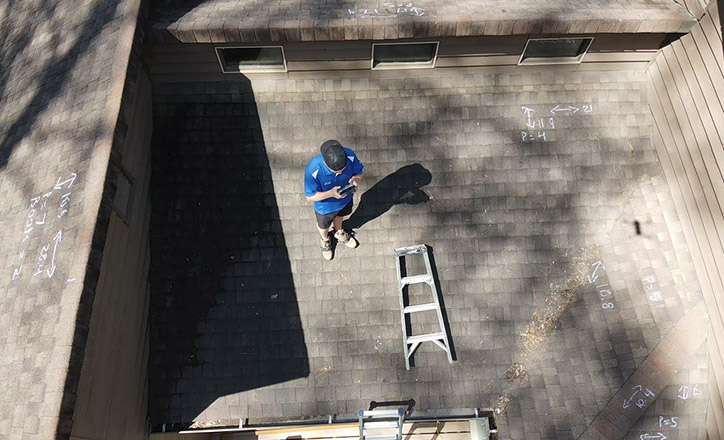
The most common question we get regarding insurance is:
“Will filing a claim cause my premium to go up?”
Typically, filing a wind or hail damage claim does not increase your insurance rates. Insurance premiums are usually determined by the region you live in, rather than individual claims. It’s important to note that home insurance operates differently from auto insurance. Furthermore, at Edge Roofing, we go the extra mile by assisting you in understanding the coverage provided by your policy. Our team will review your declaration page with you to ensure that any damages we have identified are covered under your policy.
Filing a claim is a simple and efficient process. To get started, all you need to do is contact the claims number and inform them that you had an inspection done by Edge Roofing which revealed storm damage to your roof. They will then gather some necessary details from you and assign a claim number for reference. The next step involves arranging a meeting with your insurance adjuster to assess the situation further.
Step 4
Meeting the insurance adjuster at your home to show them what we found
After you submit a claim, you can expect to receive a call from your insurance provider within 1-2 days. During this call, they will schedule an appointment for an insurance adjuster to inspect your roof. We highly recommend being present during the inspection so that we can assist the adjuster with any necessary information or support. Typically, these appointments last approximately 30 minutes.
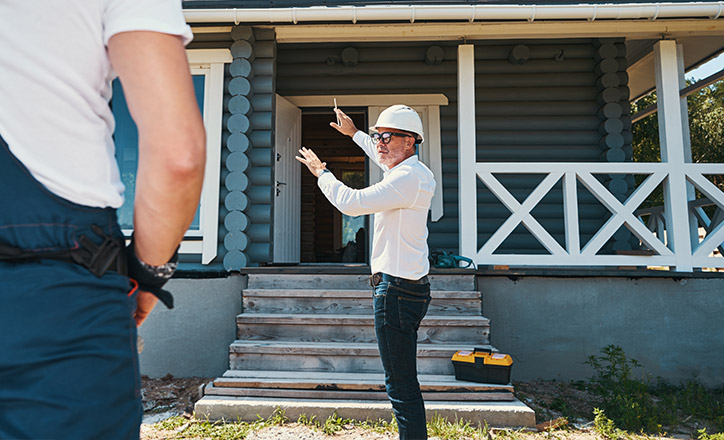
During the assessment process, both your sales representative from Edge Roofing and your insurance adjuster will physically inspect the damage on your roof. The insurance adjuster specifically examines the shingles affected by wind, hail, etc., and conducts a brittle test as well. This test determines whether the damaged shingles are suitable for repairs or if they would sustain further damage during the repair process. If a shingle fails the brittle test, it indicates that attempting a repair could potentially worsen the existing problem on your roof. In such cases, a full replacement would be recommended to avoid any complications or additional damage. If your shingles are damaged and fail a brittle test, you can count on your home insurance company to cover the cost of replacing your roof.
Step 5
Insurance covering the cost of your new roof
Once the adjuster has examined your roof and determined that it requires replacement, they will proceed to provide you with a formal document known as a scope. The scope outlines the cost of the new roof and specifies what your insurance company is willing to cover. You can then discuss this document with Edge Roofing who will address any queries or concerns you may have. Once all parties are satisfied, your insurance company will issue a check for the approved amount, and Edge Roofing will schedule the installation of your new roof.
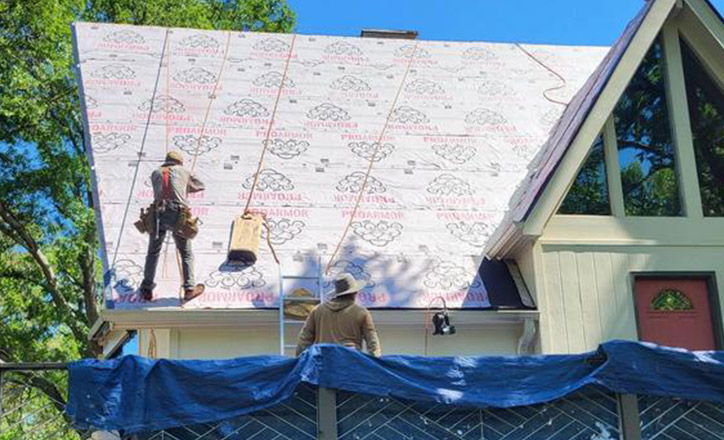
Step 6
Scheduling your free roof inspection
Scheduling a roof inspection has never been easier. You have two convenient options: you can either use the form below or call us at 833-468-3343 and make sure to mention you called from the website. Whichever method you choose, our team will be ready to assist you in getting your inspection scheduled quickly and efficiently.
Get a FREE inspection!
Fill out your info below and we will contact you.

Step 6
Scheduling your free roof inspection
Scheduling a roof inspection has never been easier. You have two convenient options: you can either use the form below or call us at 833-468-3343 and make sure to mention you called from the website. Whichever method you choose, our team will be ready to assist you in getting your inspection scheduled quickly and efficiently.
Get a FREE inspection!
Fill out your info below and we will contact you.
Step 6
Scheduling your free roof inspection
Scheduling a roof inspection has never been easier. You have two convenient options: you can either use the form below or call us at 833-468-3343 and make sure to mention you called from the website. Whichever method you choose, our team will be ready to assist you in getting your inspection scheduled quickly and efficiently.
Get a FREE inspection!
Fill out your info below and we will contact you.

Our Hardie® Siding Products
Hardie®
Plank Lap Siding
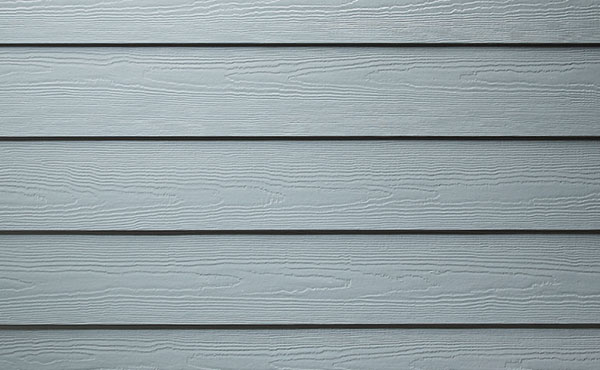
Hardie®
Trim Boards
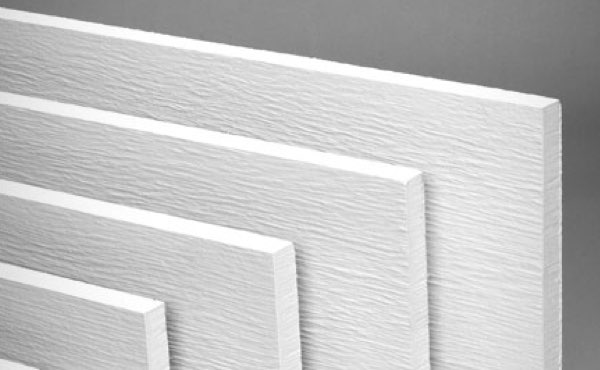
Hardie®
Panel Vertical Siding
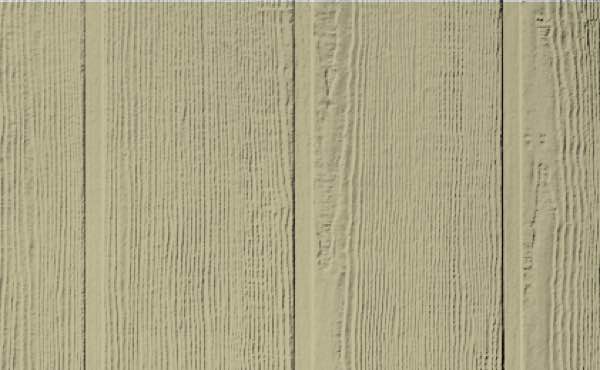
Hardie®
Shingle Siding
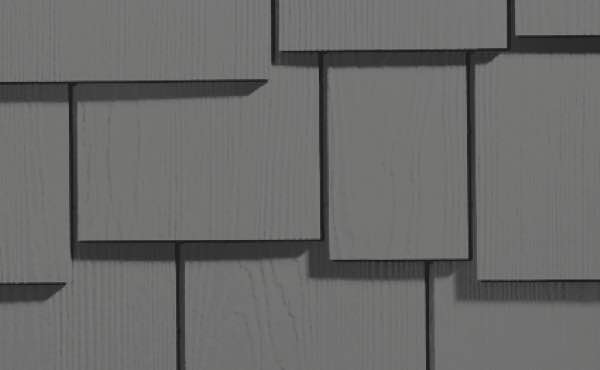
Client Testimonials
Great experience overall! Roof was replaced in a couple of hours. The contractor responded instantly with any questions I had. If you’re looking for a roofing company that takes pride in their work, communicative, and experienced, I would definitely recommend using Edge Roofing.
Edge installed a new roof. They did a superb job for a very competitive price and were a joy to work with: not pushy, they were very patient to wait until we were ready to start the project. Customer satisfaction and integrity were evident throughout the project. We love our new roof and Edge Roofing!
We had a great experience with this company. We highly recommend Jordan. He helped us along every step of the process and went above and beyond all expectations. If you need a new roof call Jordan’s and you won’t be disappointed.

